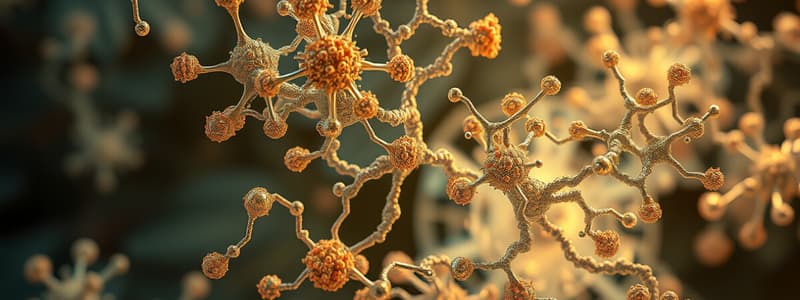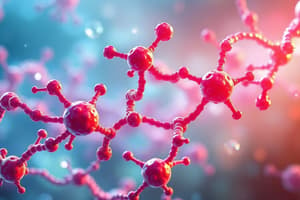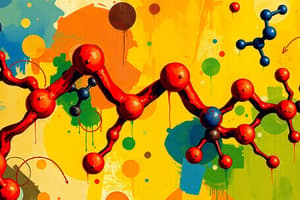Podcast
Questions and Answers
What type of carbonyl group is present in aldoses?
What type of carbonyl group is present in aldoses?
- Ketone
- Aldehyde (correct)
- Alcohol
- Carboxylic acid
In Fischer projection, how is the configuration of D or L determined?
In Fischer projection, how is the configuration of D or L determined?
- By the position of the hydroxyl group on the highest-numbered chiral center (correct)
- By the type of carbonyl group present
- By the overall number of chiral centers
- By the length of the carbon chain
What term describes the single units that constitute polymers?
What term describes the single units that constitute polymers?
- Polymers
- Monomers (correct)
- Enzymes
- Macromolecules
What is the smallest monosaccharide that can exist?
What is the smallest monosaccharide that can exist?
Which macromolecule is formed from monosaccharides?
Which macromolecule is formed from monosaccharides?
What do enantiomers exhibit different properties in?
What do enantiomers exhibit different properties in?
Which of the following is NOT considered a polymer?
Which of the following is NOT considered a polymer?
What type of monosaccharide is a hexose with an aldehyde functional group called?
What type of monosaccharide is a hexose with an aldehyde functional group called?
Which statement is true regarding the behavior of ordinary light compared to plane-polarized light?
Which statement is true regarding the behavior of ordinary light compared to plane-polarized light?
What reaction type is described as the conversion of monomers to macromolecules?
What reaction type is described as the conversion of monomers to macromolecules?
What characterizes a monosaccharide classified as a ketose?
What characterizes a monosaccharide classified as a ketose?
Who is known as the father of biochemistry?
Who is known as the father of biochemistry?
What is the carbon atom count in a pentose monosaccharide?
What is the carbon atom count in a pentose monosaccharide?
What type of monomer do proteins consist of?
What type of monomer do proteins consist of?
What is the process called when large molecules are broken down into smaller particles?
What is the process called when large molecules are broken down into smaller particles?
Which of the following is the building block of nucleic acids?
Which of the following is the building block of nucleic acids?
What are carbohydrates primarily composed of?
What are carbohydrates primarily composed of?
Which of the following is a characteristic of polysaccharides?
Which of the following is a characteristic of polysaccharides?
What type of carbohydrate is cellulose classified as?
What type of carbohydrate is cellulose classified as?
What fundamental functional groups are present in carbohydrates?
What fundamental functional groups are present in carbohydrates?
How can carbohydrates be classified based on molecular size?
How can carbohydrates be classified based on molecular size?
What is meant by 'handedness' in carbohydrate molecules?
What is meant by 'handedness' in carbohydrate molecules?
What defines non-superimposable mirror images in carbohydrates?
What defines non-superimposable mirror images in carbohydrates?
What process do polysaccharides undergo to produce monosaccharides?
What process do polysaccharides undergo to produce monosaccharides?
What is the classification of Dihydroxyacetone in terms of chirality?
What is the classification of Dihydroxyacetone in terms of chirality?
Which of the following is a primary source of energy for cells?
Which of the following is a primary source of energy for cells?
How do insulin and glucagon function with respect to glucose levels?
How do insulin and glucagon function with respect to glucose levels?
What is a common source of glucose in nature?
What is a common source of glucose in nature?
Which term refers to the six-membered ring formed by D-Galactose?
Which term refers to the six-membered ring formed by D-Galactose?
Which sugar is often referred to as 'brain sugar'?
Which sugar is often referred to as 'brain sugar'?
What is the chemical structure of D-Fructose when cyclized?
What is the chemical structure of D-Fructose when cyclized?
What is the typical blood glucose level considered normal?
What is the typical blood glucose level considered normal?
What is the main cause of milk souring?
What is the main cause of milk souring?
Which disaccharide is formed by a glycosidic bond characterized as a B-1-4 linkage?
Which disaccharide is formed by a glycosidic bond characterized as a B-1-4 linkage?
What is the function of the enzyme lactase?
What is the function of the enzyme lactase?
Which sugar is referred to as a non-reducing sugar?
Which sugar is referred to as a non-reducing sugar?
What type of sugar is lactose primarily considered?
What type of sugar is lactose primarily considered?
Which of the following terms describes the process that kills bacteria in milk and retards souring?
Which of the following terms describes the process that kills bacteria in milk and retards souring?
What is produced from the hydrolysis of sucrose?
What is produced from the hydrolysis of sucrose?
What monosaccharide units make up sucrose?
What monosaccharide units make up sucrose?
Flashcards are hidden until you start studying
Study Notes
Introduction to Biochemistry
- Biochemistry is the study of the chemical processes and substances essential to life.
- It examines biomolecules in living cells and organisms, as well as their reactions.
- Each biomolecule is a polymer made from monomers (basic building blocks).
Polymers and Monomers
- Types of macromolecules include carbohydrates, lipids, proteins, and nucleic acids.
- Common monomers:
- Carbohydrates → Monosaccharides
- Lipids → Hydrocarbon chains (not always polymers)
- Proteins → Amino acids
- Nucleic Acids → Nucleotides
- Key biochemical reactions:
- Anabolic reactions build larger molecules from monomers, requiring energy.
- Catabolic reactions break down larger molecules into monomers, releasing energy.
History and Development
- Carl Neuberg (1903) is recognized as the Father of Biochemistry.
- He identified enzymes as catalysts and discovered nucleic acids as information carriers.
Handedness and Fischer Projection
- Fischer projection is used to depict spatial arrangements of chiral molecules.
- Carbon chains are numbered from the carbonyl group end to determine D or L configurations.
- Enantiomers differ in interaction with polarized light and other chiral substances.
Classification of Monosaccharides
- Monosaccharides are classified as aldoses (aldehyde group) or ketoses (ketone group).
- Examples:
- Triose: 3 carbons
- Tetrose: 4 carbons
- Pentose: 5 carbons
- Hexose: 6 carbons (D-Galactose and D-Fructose are examples).
Polysaccharides
- Comprise many monosaccharides linked together and can be broken down into simpler sugars.
- Common polysaccharides: Cellulose and Starch, both prevalent in plants.
Structural Properties of Carbohydrates
- Carbohydrates possess functional groups: aldehyde (single bond) and ketone (double bond).
- Handedness in molecules leads to the concept of mirror images, with non-superimposable forms indicating chirality.
Monosaccharides and Their Forms
- D-Glucose - Blood sugar, found in ripe fruits, is vital for energy; normal blood levels: 70-90 mg/dL.
- D-Galactose - "Brain sugar," a component of glycoproteins, synthesized from glucose in mammary glands.
- D-Fructose - The sweetest sugar, found in fruits and honey, important ketohexose.
Cyclic Forms of Monosaccharides
- D-Glucose can form a six-membered ring (pyranose), while Fructose and Ribose form five-membered rings (furanose).
Disaccharides
- Sucrose (table sugar) is the most abundant disaccharide, produced from sugar cane and beets; its glycosidic bond is α-β-1-2 linked.
- Lactose (milk sugar) is composed of β-D-Galactose and D-Glucose; it is a reducing sugar.
Important Enzymes
- Cellobiase breaks down cellobiose; sucrase breaks down sucrose.
- Lactase hydrolyzes lactose, supporting digestion in infants.
- Pasteurization of milk is a process that kills bacteria to prevent souring.
Summary of Interactions and Properties
- Glycosidic linkages dictate the digestibility of sugars, with colobiose being indigestible by humans.
- Lactose is a significant sugar in milk, and its breakdown product during fermentation (lactic acid) contributes to milk souring.
Studying That Suits You
Use AI to generate personalized quizzes and flashcards to suit your learning preferences.




